![]()
Bohemian Paperweights for Sale
![]()
Bohemian Paperweights for Sale
The paperweights on this page are all various Bohemian factories. These factories were made in the glass making regions that are today in the border area between the Czech Republic and Poland. There is documentation to suggest that some of these factories engaged in the manufacture of millefiori as early as 1833. In the past, paperweight collectors identified paperweights from this region as simply Bohemian. More correctly, the glassworks were located in Prussia, Austria, Poland, and the Czech Republic. Paperweights of this type are becoming more in demand as collectors find out more about the various German and Bohemian factories.
For more information, you can read about paperweights from Germany and Bohemia in the book by von Brackel Paperweights: Historicism - Art Nouveau - Art Deco - 1842 to today and in the book by Marek Kordasiewicz Glass Paperweights: The Heritage of the 19th Century Riesengebirge and Isergebirge Glassworks.For some great references on paperweights, check out my list of paperweight books for sale.
If you would like to purchase
any of these paperweights, e-mail me at: aport@paperweights.com
| 6216 | Antique Thuringia or
Bohemia Concentric Millefiori Paperweight with Basket
Ground. circa 1870 - 1940. Colorful antique
concentric paperweight with three rings of millefiori canes
arranged around a center cane. There are four different cane
types. The design is placed in a basket ground. The
glass is slightly gray. An interesting example of a type of
weight that is becoming more in demand as collectors learn more
about the various Bohemian and German factories. The maker of this paperweight is unknown, except that it is believed to originate in Thuringia. Previously we would say this is from Bohemia, the region along the Czech - German border, but more specific information has revised that attribution to be more specific. Similar paperweights are on display in the museum in Lauscha and are identified as being from Lauscha in Thuringia. The area was part of Bohemia prior to WWI. Examples can be found in the book by Peter von Brackel, Paperweights: Historicism - Art Nouveau - Art Deco - 1842 to Today. Size: 2 3/8" diameter by 1 7/16" high. The
top has a flattened profile. The base is ground
flat. The glass is slightly gray. For extra pictures, click on the picture at the right and the following links: Large picture$145 postage paid in the US. Click on the picture to see a larger image. |
Click
on the picture to see a larger image 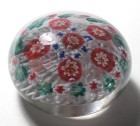 |
| 1550 | Large Vintage Czech / Bohemian Faceted
Masaryk Picture Paperweight. circa
1900-1939. Large faceted paperweight with a picture of Tomá
Garrigue Masaryk, the first president of Czechoslovakia. The
picture is placed on a tombstone (or picture frame) shaped
sulphide that rests on a multicolored cushion of glass bits.
The tombstone has ornamental features on each side of the
picture. On the back of the tombstone is a large brightly
colored orange and amber bouquet of flowers. The paperweight
has a complex faceting with one large window facet in front, an
eight part facet at the top, and 24 other side facets for a total
of 33 facets on four levels. The paperweight was made in
Northern Bohemia during the period 1900 to 1939. It weighs
almost 23 ounces. An important paperweight of historical
significance. Von Brackel refers to the style as picture frame sulphides, rather than tombstones, but does not account for the presence of the flowers on the reverse side. This paperweight has no writing on the tombstone, but I have had others with the same or similar pictures that had the name "T. G. Masaryk" under the picture. Masaryk was the president of Czechoslovakia from 1918 to 1935. He died in 1937 at the age of 87. The picture was taken earlier in his life. Most likely this paperweight was produced during his presidency or possibly at the time of his death. It is also possible that it was produced earlier in his life when he was a political activist advocating for the creation of an independent Czechoslovakia. Von Brackel discusses this style of paperweight in his book Paperweights - Historicism - Art Nouveau - Art Deco . He discusses several similar examples on pages 102 to 105 with a range of values of $250 and up. The picture format, he says is a specialty of Northern Bohemia. Large size: Just under 3" at the widest by just over 3
1/2" high. The base is ground flat. Faceted with a
total of 33 facets. It weighs just under 23 ounces. For extra pictures, click on the picture at the right and the following links: Large picture$145 postage paid in the US. Click on the picture to see a larger image. |
Click on the picture
to see a larger image 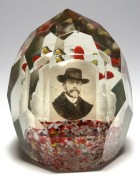 |
| 5087 | Vintage Thuringia Lauscha Bohemia
Paperweight with Name Plaque "Karl Laur". Circa
1920-1939. Colorful vintage paperweight with a central name
plaque over a two layer frit ground. There are four icepick
flowers each with a bubble in the center. The name on the
plaque is Karl Laur. An interesting example of a name weight
that is popular with many some collectors. The maker of this paperweight is unknown, except that it is believed to originate either in Thuringia (now part of Germany) or in the region along the Czech - German border, hence the label Bohemian. Similar paperweights have are on display in the museum in Lauscha and are identified as being from Thuringia. Some examples can be found in the book by von Brackel, Paperweights: Historicism - Art Nouveau - Art Deco - 1842 to Today See pages 220-221 in particular figure 510. Both paperweights in this figure may have been decorated by the same hand as this paperweight. Size: 2 1/3" diameter by 1 11/16" high. The base
is ground flat. There is a small circular remainder of the
pontil mark in the center. For extra pictures, click on the picture at the right and the following links: Large picture$75 postage paid in the US. Click on the picture to see a larger image. |
Click
on the picture to see a larger image 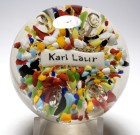 |
| 848 | Czech / Bohemian Faceted Morning Glories
Trumpet Flower Paperweight. circa
1880-1925. Trumpet flower paperweight with five
blossoms. There is one large blue center flower and four
smaller multicolored flowers at a lower level. There is a
planned bubble in the center of each flower. The flowers are
pushed down to a green frit flower pot shaped ground. The
glass is heavy crystal. This paperweight is faceted with 32
facets arranged in four rows. A wonderful example. Note on condition: Good condition for its age. There are chips on the edges of some of the facets, but no major damage. This style is also called an icepick flower because of the sharp tool used to push each flower down to the base. Some authors call these morning glory flowers. Von Brackel discusses this style in his book He lists many variations on pages 106 to 149 with a wide range of values up to $300 and more. On pages 278 & 279 he describes the process used to make a trumpet flower paperweight. Size: 2 7/8" diameter by 3 1/8" high. The
bottom is polished flat with a remnant of the pontil mark. For extra pictures, click on the picture at the right and the following links: Large pictureSOLD. Click on the picture to see a larger image. |
Click on the picture
to see a larger image 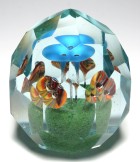 |
| 2254 | Antique Thuringia Lauscha Millefiori
Paperweight with Name Plaque "Hauptm. Karl". Circa
1870 - 1940. Colorful antique paperweight with colorful
millefiori canes arranged around a central name plaque. The
name "Hauptm. Karl" is probably an abbreviation of "Hauptmann
Karl", meaning Captain Karl or leader Karl. The complex
millefiori canes repeat in alternating patterns to make up the
design with 26 canes in all. The pattern is arranged over a
multicolored frit ground. There are some wonderful complex
canes in this paperweight. An interesting example of a type
of weight that is becoming more in demand as collectors learn more
about the various Bohemian factories and eastern Germany
factories. This is a relatively rare item. Similar paperweights are on display in the museum in Lauscha and are identified as being from Lauscha in Thuringia. Examples can be found in the book by von Brackel, Paperweights: Historicism - Art Nouveau - Art Deco - 1842 to Today See pages 90-95 and figure 507 on page 221. Large Size: 2 3/4" diameter by 1 11/16" high. The
base is ground flat with a matte finish. There is a
depression remaining from the pontil mark in the center. For extra pictures, click on the picture at the right and the following links: Large picture$135 (was $195) postage paid in the US. Click on the picture to see a larger image. |
Click
on the picture to see a larger image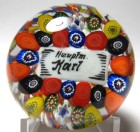 |
| 2528 | Antique Belgian or Bohemian Doorknob
with Miniature Concentric Millefiori Paperweight
Handle. circa 1880-1910. This is
a wonderful antique doorknob with a concentric millefiori
paperweight handle. The handle has bright colors on a clear
ground. It has two concentric circles of canes around a
complex center cane. The outer ring alternates between
larger complex blue and white canes and simpler red and white
canes. One red cane is missing. The inner ring
consists of six large identical white, pink, and yellow complex
canes. There is a complex green, pink, and yellow center
cane. The maker of this paperweight is unknown. It has
similarities to a group of paperweights believed to have
originated at an unidentified glass factory in Belgium, Northern
Europe, or even Bohemia. The hardware portion is in good
condition with a fixed spindle. The design is well centered
and a wonder to study. This paperweight has a strong similarity to a group of paperweights and doorknobs that are believed to have originated at an unidentified glass factory in Belgium or Northern Europe. Bohemian Glass generally refers to the glass made in the regions that form the border area between the Czech Republic, Poland, and Germany. Most of these areas are now parts of the western Czech Republic. Size: The knob is 1 13/16" diameter by 2 3/16"
long including the brass hardware, but not the spindle.
With the spindle, it is 4 13/16" long. For extra pictures, click on the picture at the right and the following links: Large pictureSOLD. Click on the picture to see a larger image. |
Click on the picture
to see a larger image  |
| 3668 | Antique Bohemian Concentric Millefiori
Paperweight with Complex Canes. circa
1850-1900. This is an antique Bohemian millefiori
paperweight with some interesting complex millefiori canes.
The paperweight has three concentric circles of canes around a
complex center star cane. The design consists almost
entirely of complex canes, with the exception of the red and white
canes in the second ring. In all a complex design built from
a variety of canes with many star canes. The design is well
executed and it is in perfect condition. The glass is
slightly grey. This paperweight has been professionally
restored. Bohemian Glass generally refers to the glass made in the regions that form the border area between the Czech Republic, Poland, and Germany. Most of these areas are now parts of the western Czech Republic. Size: Just over 2 1/4" diameter by 1 5/16"
high. The base is ground concave. For extra pictures, click on the picture at the right and the following links: Large pictureSOLD. Click on the picture to see a larger image. |
Click
on the picture to see a larger image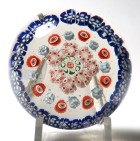 |
| 2270 | German or Bohemian Souvenir Paperweight
with Ruby Stain Engraved Scene of Münster in
Freiburg. circa 1840-1910. This
is a large footed paperweight with an engraved image of the
cathedral of Freiburg im Breisgau in southwest Germany.
There are initials after the title which I assume are those of the
engraver. The engraving is done from the bottom which has a ruby
stain. The paperweight has a footed or pedestal base.
The techniques used in this type of paperweight are attributed to the pioneering work with colored stains (sometimes incorrectly called flash overlays) by Friedrich Egermann (1774-1864) in North Bohemia. Egermann discovered methods of applying metallic salts to glass to produce a colored stain. Silver salts would produce a yellow stain, copper salts would produce a ruby stain, etc. The application of this colored layer enabled many Bohemian (and also European) glass factories to engrave a variety of images as souvenirs of the prominent buildings and spas throughout Europe. The style became known as spa paperweights. Although the technique was enabled by Egermann's discoveries, it is not possible to attribute this paperweight to a specific factory, engraver, or country. There is an excellent article this subject with many examples in the 2016 Annual Bulletin of the Paperweight Collectors Association "19th Century Engraved Bohemian Paperweights: Spas and Other Local Views" by Jim and Nancy Barton. Bohemian Glass generally refers to the glass made in the regions that form the border area between the Czech Republic, Poland, and Germany. Most of these areas are now parts of the western Czech Republic. Size: 3 7/8" diameter by approximately 1 3/8"
high. The foot has a diameter of 3 1/2". For extra pictures, click on the picture at the right and the following links: Large picture$135 postage paid in the US. Click on the picture to see a larger image. |
Click
on the picture to see a larger image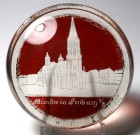 |
|
|
|
Back to Allan's Paperweights (www.paperweights.com)
Revised 7/19/2025 IE